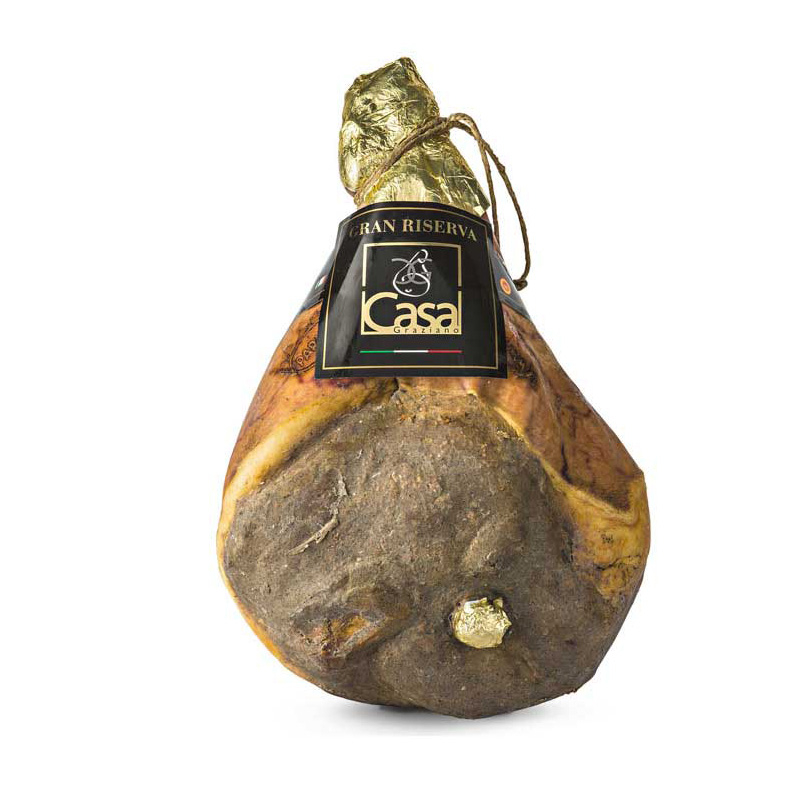
Description
Prosciutto di Parma DOP Casa Graziano Riserva with bone is one of the most famous and appreciated Made in Italy products worldwide. The ancient processing method has been passed down through generations; high-quality raw materials are chosen. No preservatives or additives are used in Parma ham; Casa Graziano uses only top-quality pork, spices, and a little sea salt. The territory is one of the keys to the success of Parma ham: the hills of Parma are characterized by a mild climate, with dry and delicate air: in this context, the natural aging of Prosciutto di Parma DOP Casa Graziano Riserva occurs, giving this prized cured meat its unmistakable sweetness and delicacy, loved throughout Italy and abroad. CERTIFIED BY A CONTROL BODY AUTHORIZED BY MIPAAF. Pairings: Parma ham is excellent consumed pure, as an appetizer accompanied by medium-aged cheeses. We recommend pairing it with a Lambrusco or an Oltrepò Barbera, also great with a glass of Franciacorta. Storage: Store in a cool, dry place. Processing: For the production of Parma ham, there is a strict regulation imposed by the Consortium of producing companies in full respect of tradition. The exclusivity of this cured meat begins with the selection of pigs, which must be of a single breed: Large White, Landrace, and Duroc, and fed with quality foods, including whey derived from Parmigiano Reggiano. The legs are cooled in special cells for 24 hours, and then trimming is done, removing parts of fat and rind to give the leg a rounded shape. This shape, besides being characteristic of the ham, is also useful for subsequent salting. Salting is a delicate and complex phase that involves covering the leg with salt. This operation is carried out by skilled hands, and the difficulty lies in using the correct salt (wet on the rind parts and dry on the lean parts) when the leg is at a precise and uniform temperature. Subsequently, the legs are placed in a refrigerator cell for 15-18 days, then rest in a new refrigerated cell for the same number of days once cleaned and re-salted. At the end of this period, the residual salt is removed, and the legs remain at rest. After more than 60 days, the legs are rinsed with warm water to remove impurities and residues and are left to dry in the sun on cool and breezy days. They are then hung on "scalere," a sort of wardrobe in well-ventilated rooms to allow natural, gradual, and constant drying. The next phase is called "sugnatura" and involves covering the muscular part with lard, a mixture of fat and ground pepper to soften the outer layers. Starting from the seventh month, the Prosciutto can be placed in cellars, establishments designated for aging, which play a crucial role in imparting the typical aromas and flavors to the ham. Only after a year and several inspections by the Inspectors of the Parma Quality Institute can Parma ham be branded and destined for sale. Aging: 22 Other: Nutritional values per 100g: Energy value (calories) 267 kcal Proteins 26 g Carbohydrates < 0.5 g sugars 0.00 g Fats 18 g saturated 6.12 g Salt 4.4g
Nutritional Analysis
Attention
Macronutrients (100 gr)
| Energy (kcal) | 267 |
| Carbohydrates (g) | 0.5 |
| Fat (g) | 18 |
| of which Saturates (g) | 6.12 |
| Protein (g) | 26 |
| Sale (g) | 4.4 |
Nutritional Analysis
- Proteins26g·58%
- Carbohydrates0.5g·1%
- Fats18g·40%
- Fibers0g·0%
